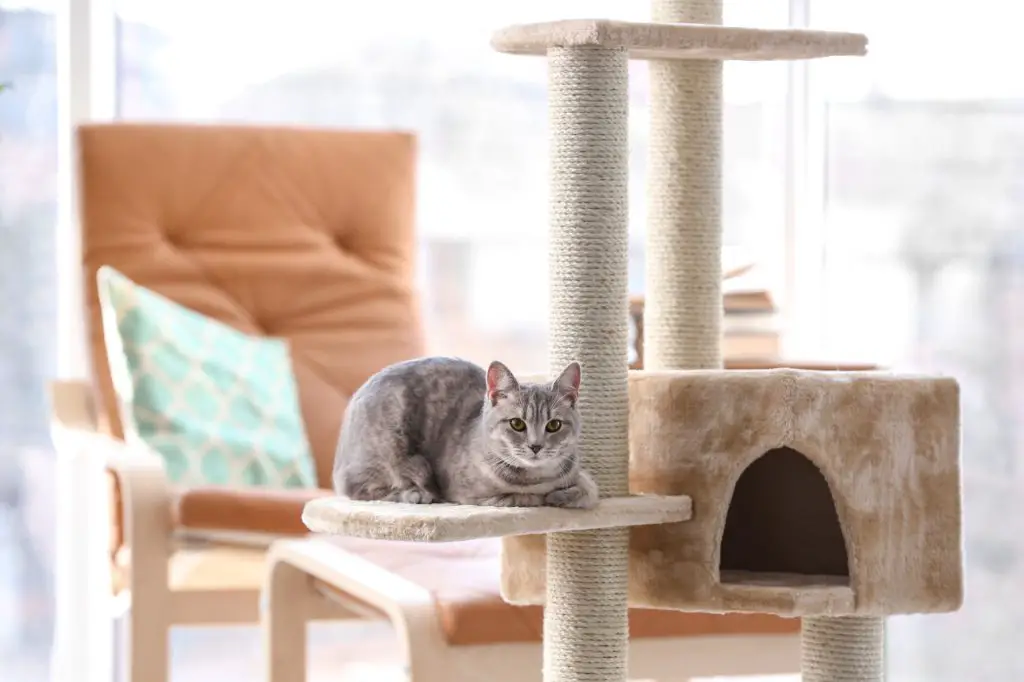A female cat can have over 100 kittens in her reproductive lifetime, but is the process painful? And why do cats scream when mating?
Before breeding your cats, it’s important to understand the mating process and the impact on male and female cats. Continue reading to learn how to offer the best pet care for your furry friends.

Contents
Cat Mating Process
To understand ‘why do cats scream when mating,’ it’s important to also understand the mating process. The process starts when a female cat enters their heat cycle.
Heat Cycle for Female Cats
Once male and female cats reach their reproductive age, they are fertile until they’re spayed or neutered. During a female cat’s heat cycle, the behavior of both male and female cats changes.
Breeding Season
The heat cycle occurs regularly throughout the breeding season. While most commercial breeders breed cats between the months of March and September, this can extend from February to December.
Fertile Age
Cats reach sexual maturity at the relatively young age of four to six months. Once a cat reaches sexual maturity, they’re able to breed and become pregnant.
Cycle Length
After reaching maturity, they will go into heat approximately every two to three weeks, which can last a period of a few days to up to 2 weeks. The heat cycle is an ongoing process.
Behavior in Female Cats
One of the most obvious signs that a cat is in heat is a change in behavior. Most notably, they seem needier and craving attention. Even cats with an aloof tendency become more affectionate.
Cats crying or yowling while in heat is another common behavior. Experts believe this is to attract the attention of potential mates in the area. This is also why female cats urinate more frequently and in inappropriate places.
Behavior in Male Cats
Female cats aren’t the only ones experiencing a behavioral change during the heat cycle. Male cats are also affected by the sounds and pheromones produced by a female in heat.
They tend to show more aggression and assertiveness. Behaviors include spraying inside of the house, getting into catfights, and roaming far distances in search of a mate.
Why Do Cats Scream When Mating?
Once male and female cats locate each other it’s not uncommon to hear cats crying during the mating process. It can be as mild as loud yowling or as aggressive as screaming. The behavior is related to the male cat’s reproductive organs.
Barbed Reproductive Organs
A cat’s penis is lined with small spines that present themselves during the mating process. The spines are thought to help stimulate ovulation in female cats.
The process is excruciating for female cats, which is why they scream. Male cats sometimes scream in response to the females.
Post-Mating Aggression
After mating, female cats may become aggressive toward the males. It’s common for her eyes to dilate and for her to cry out for a short period of time before attacking. The aggression may be related to the pain caused by the mating process.
Feline Pregnancy
A female cat is likely to attempt breeding multiple times during the heat cycle to ensure pregnancy. This can mean three to four matings during the ovulation period, which is approximately 24 hours.
Feline Gestation
Due to these repeated matings, it’s possible for a litter to have different fathers. If a cat becomes pregnant, the gestation period is approximately 64 to 71 days or an average of 9 weeks.
Signs of Pregnancy
You won’t be able to tell that your cat is pregnant for the first two to three weeks after the mating process. Some of the first signs of pregnancy include a stop in the heat cycle, increased appetite, and vomiting (similar to human morning sickness).
Other signs of pregnancy include:
- Swelling nipples
- Weight gain
- Increased amount of time sleeping
- Nesting behavior
- Abdominal swelling
If you want to be certain of your cat’s pregnancy, you can take her to her veterinarian. They can test for pregnancy in 3 ways including palpation of the abdomen, x-rays, or an ultrasound. Ultrasound and palpation are the quickest indicators.
Routine Pet Care for Pregnant Cats
Whether you want to know for certain about your cat’s pregnancy or not, we recommend scheduling regular veterinary visits for pet care during pregnancy. This will help ensure the health of the mom and kittens.
Litter Size
A cat’s first litter of kittens is often its smallest litter. A cat most commonly gives birth from one to 10 kittens per litter. However, this varies depending on age and breed as well.
It’s important to know how many kittens to expect during delivery. Some new mothers may not be able to birth all of their kittens. This can be fatal to both the kitten and the mother.
How to Avoid Feline Pregnancy
If you don’t want the responsibility of one to 10 newborn kittens, then it’s important to learn how to avoid feline pregnancy. This not only helps protect your cat from a painful mating process, but it can also benefit them in other ways as well.
Keep Your Cat Indoors
One method of preventing feline pregnancy is to keep your cat indoors at all times. If you have more than one unaltered cat, then you’ll have to keep them in separate areas of the house where they can’t access each other.
It’s important to keep in mind that this isn’t a guaranteed method of preventing pregnancy. Cats are quick and clever and can escape easily.
Spay/Neuter Cats
One of the best forms of pet care possible is spaying and neutering your cats. This is the only way to completely prevent female cats from becoming pregnant. This can be done at a spay/neuter clinic or at most veterinary offices.
When to Spay/Neuter Cats
While a cat doesn’t reach sexual maturity until the age of 4 to 5 months, spaying and neutering are safe for cats at a much younger age. Many animal shelters and veterinary clinics perform these procedures on kittens as young as 8 weeks.
Importance of Spaying/Neutering Cats
Spaying and neutering cats is an essential part of pet care. One of the most obvious benefits is that you don’t have to listen to cats crying from a painful mating process. However, there are other benefits worth considering as well.
Avoids Overpopulation of Cats
One of the most important benefits of spaying and neutering cats is reducing the number of homeless cats in the world. This process helps reduce the number of homeless cats euthanized daily in animal shelters.
Offers Medical Benefits
While altering male and female cats is beneficial for humans, it also offers medical benefits for these cats. Unaltered female cats are at high risk of uterine infections and breast tumors, which are cancerous in approximately 90% of cats.
Unaltered male cats are also at risk of developing health problems. They face testicular cancer and problems with their prostate. Neutering prevents testicular cancer and helps reduce the risk of prostate problems.
Offers Behavioral Benefits
Altering cats is beneficial in alleviating behavioral problems relating to mating season and a female cat’s heat cycle. Without these aggressive hormones, female cats won’t yowl throughout the night or urinate in the house.
Since male cats can experience increased aggression during the heat cycle, they are at an increased risk of being injured in a fight. They also can get lost or put themselves in danger when they roam far from home in search of a mate.
Spay/Neuter Cat Facts
While there are many benefits associated with spaying and neutering cats, some pet owners have been given misinformation about the process.
This either causes unnecessary fear of the process or sets unrealistic expectations. Understanding these cat facts can help avoid both of these problems.
Weight Concerns
One common concern regarding altering cats relates to a cat’s weight. Pet owners worry that their cat will become overweight as a result of the change in hormones from being altered.
However, this isn’t the case. Cats become overweight as a result of poor diet habits and a lack of exercise. So long as the cat is on a healthy diet, fed the right amount, and regularly exercised, they won’t become overweight.
Missing Benefits of Heat Cycle
A common piece of misinformation relates to the heat cycles of female cats. Some people believe their cat needs to have one heat cycle or one litter of kittens to live a healthy life, but there’s no evidence to support either claim.
Fixing All Behavioral Problems
When a pet exhibits behavioral problems, some pet owners are under the impression that spaying and neutering will fix them. While the process can help resolve certain behavioral problems, it isn’t a cure-all.
It’s important to talk to a veterinarian about a pet’s behavioral problems to find a solution. If the behavior doesn’t resolve with spaying and neutering, then additional pet care or training may be necessary.
Why Do Cats Scream When Mating – Now You Know
While the answer to, ‘why do cats scream when mating,’ isn’t a pleasant one, it’s important to understand. Pet care for pregnant female cats is stressful and the risks from leaving them unaltered are substantial.
For more pet care tips and guides, visit the cat section of our blog.



